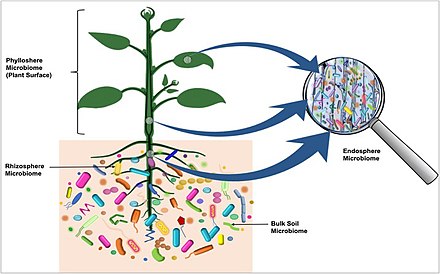مجهريات البقعة
مجهريات البقعة | |
|---|---|
| تعديل مصدري - تعديل |

مِجْهَرِيَّاتُ البُقْعَة[2] هي مجموعة من الكائنات الحية الدقيقة التي قد تكون متكافلة أو متبادلة أو مسببة للأمراض الموجودة في جميع الكائنات متعددة الخلايا، بما في ذلك النباتات. تشمل الكائنات الحية الدقيقة على البكتيريا، والعتائق، والطلائعيات، والفطريات، والفيروسات[3][4]، وقد وجد أنها ضرورية للتوازن المناعي والهرموني والاستتباب لمضيفها.
يصف مصطلح الميكروبيوم إما الجينوم الجماعي للميكروبات التي تعيش في مكان بيئي أو الميكروبات نفسها.[5][6][7]
ظهر الميكروبيوم والمضيف أثناء التطور كوحدة تآزرية من علم التخلق والخصائص الوراثية، والتي يشار إليها أحيانًا بشكل جماعي باسم holobiont.[8][9] كان وجود الكائنات الحية الدقيقة في أحشاء الإنسان وغيره من الكائنات الحية الدقيقة أمرًا بالغ الأهمية لفهم التطور المشترك بين الكائنات الحية الدقيقة والبكتيريا.[10][11] تلعب الكائنات الحية الدقيقة أدوارًا رئيسية في الاستجابات المناعية والتمثيل الغذائي المعوي من خلال إنتاج التخمير (الأحماض الدهنية قصيرة السلسلة)، والأسيتات.[12]
المراجع
[عدل]- ^ Dastogeer, K.M., Tumpa, F.H., Sultana, A., Akter, M.A. and Chakraborty, A. (2020) "Plant microbiome–an account of the factors that shape community composition and diversity". Current Plant Biology, 23: 100161. دُوِي:10.1016/j.cpb.2020.100161.
 Material was copied from this source, which is available under a Creative Commons Attribution 4.0 International License.
Material was copied from this source, which is available under a Creative Commons Attribution 4.0 International License.
- ^ وآخرون، ميشال إبراهيم (1 يناير 2010). Dictionary of Medical Terms (English/Arabic): قاموس المصطلحات الطبية - انكليزي/عربي. Dar Al Kotob Al Ilmiyah دار الكتب العلمية. ISBN:978-2-7451-5027-1. مؤرشف من الأصل في 2024-06-10.
- ^ De Sordi، Luisa؛ Lourenço، Marta؛ Debarbieux، Laurent (2019). "The battle within: interactions of bacteriophages and bacteria in the gastrointestinal tract". Cell Host & Microbe. ج. 25 ع. 2: 210–218. DOI:10.1016/j.chom.2019.01.018. PMID:30763535. S2CID:73455329.
- ^ Peterson، J؛ Garges، S؛ وآخرون (2009). "The NIH Human Microbiome Project". Genome Research. NIH HMP Working Group. ج. 19 ع. 12: 2317–2323. DOI:10.1101/gr.096651.109. PMC:2792171. PMID:19819907.
- ^ Backhed، F.؛ Ley، R. E.؛ Sonnenburg، J. L.؛ Peterson، D. A.؛ Gordon، J. I. (2005). "Host-Bacterial Mutualism in the Human Intestine". ساينس. ج. 307 ع. 5717: 1915–1920. Bibcode:2005Sci...307.1915B. DOI:10.1126/science.1104816. PMID:15790844. S2CID:6332272. مؤرشف من الأصل في 2023-01-12.
- ^ Turnbaugh، P. J.؛ Ley، R. E.؛ Hamady، M.؛ Fraser-Liggett، C. M.؛ Knight، R.؛ Gordon، J. I. (2007). "The Human Microbiome Project". نيتشر (مجلة). ج. 449 ع. 7164: 804–810. Bibcode:2007Natur.449..804T. DOI:10.1038/nature06244. PMC:3709439. PMID:17943116.
- ^ Ley، R. E.؛ Peterson، D. A.؛ Gordon، J. I. (2006). "Ecological and Evolutionary Forces Shaping Microbial Diversity in the Human Intestine". Cell. ج. 124 ع. 4: 837–848. DOI:10.1016/j.cell.2006.02.017. PMID:16497592. S2CID:17203181.
- ^ Salvucci، E. (2016). "Microbiome, holobiont and the net of life". Critical Reviews in Microbiology. ج. 42 ع. 3: 485–494. DOI:10.3109/1040841X.2014.962478. hdl:11336/33456. PMID:25430522. S2CID:30677140.
- ^ Guerrero، R.؛ Margulis، Lynn؛ Berlanga، M. (2013). "Symbiogenesis: The holobiont as a unit of evolution". International Microbiology. ج. 16 ع. 3: 133–143. DOI:10.2436/20.1501.01.188. PMID:24568029.
- ^ Davenport, Emily R et al. "The human microbiome in evolution". BMC Biology. vol. 15,1 127. 27 Dec. 2017, دُوِي:10.1186/s12915-017-0454-7
- ^ "Evolution of the human gut flora". Andrew H. Moeller, Yingying Li, Eitel Mpoudi Ngole, Steve Ahuka-Mundeke, Elizabeth V. Lonsdorf, Anne E. Pusey, Martine Peeters, Beatrice H. Hahn, Howard Ochman. Proceedings of the National Academy of Sciences. Nov 2014, 111 (46) 16431–16435; دُوِي:10.1073/pnas.1419136111
- ^ Jugder، Bat-Erdene؛ Kamareddine، Layla؛ Watnick، Paula I. (2021). "Microbiota-derived acetate activates intestinal innate immunity via the Tip60 histone acetyltransferase complex". Immunity. ج. 54 ع. 8: 1683–1697.e3. DOI:10.1016/j.immuni.2021.05.017. ISSN:1074-7613. PMC:8363570. PMID:34107298.

